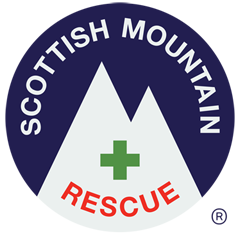Team training this month (February) focussed on winter belays and was held in Coire an Laoigh on Beinn Eighe. The snow conditions were in our favour, with the recent weather conditions stabilizing the snow pack, the snow line being about 600 meters up. 10 team members were in attendance and it was decided to split the team into two groups, with Duncan leading the group I was in, and Jim leading the other group. A pleasant walk in good conditions led us into Coire an Laoigh where we were soon up to the snow line, and our assessment of the snow conditions confirmed what we thought we would see, and backed up the latest SAIS information.
Duncan led the way and gave us a demonstration of how to construct the following:
Waist belay from a bucket seat. The key point noted here was to always try and preserve and maintain the snow pack at the front of the seat on the downside slope as this gives the bucket seat the strength and rigidity. The front face needs to be perpendicular to the angle of the slope no matter what aspect of slope the seat is built on. The seat needs to be deep enough so that your thighs are supported all the way to your knees. (Note to myself, choose a bit of snow deep enough that you don’t hit turf too soon!) Cut out a space large enough for when wearing a rucksack. Cut out a platform to the side for the rope to sit on, saving it running off down the hillside. This should always be backed up with an ice axe. We looked at the position of the axe in the snow, and attached a sling on to the axe with an inverted clove hitch, located at the balance point of the axe; this will be a different position on the shaft dependant on the axe used so check this before burying it!
The second technique demonstrated to us was how to use a dead man. Key point taken from this was to get the correct angle to the slope which must be 40 degrees to the uphill side. This is the angle that the dead man goes into the snow surface at. Again the snow downhill side of the anchor should be kept undisturbed for security. The snow behind the dead man will need to be removed to form a trough to give room to place the dead man in at the correct angle, and a slot cut into the snow on the downside slope for the dead man wire to be positioned in. Once the dead man is hammered in, pull down on the wire using a screw gate to position the dead man in place and check to see if it holds. In our case, the dead man ripped through the snow and did not hold. After attempting this in various locations all our attempts failed, due to snow pack, so this was a good example of how the snow pack can dictate the anchor choice used.
Our last example given to the team was by Gregor who gave us an example of how to construct a snow bollard. The size of the bollard will be dependent on the quality of the snow/ice and in this example the bollard was a full arm’s length from centre point. Snow must remain undisturbed inside the bollard, and once scribed and channelled out, remember to create a lip in the inside rim for the rope to sit in. The bollard made was tested out and was found to be very secure, and took the weight and strain of a couple of volunteers.
During the day all the team members practised and constructed the various different anchors, and in the afternoon we looked at combining all three types together, trying different angles to see where strengths and weaknesses were.
To finish off the day, Gregor led the team through some info he had picked up from his recent avalanche rescue training course. Gregor set up a mock avalanche area and used the new flags from the avalanche grab bag to show us how they are used. This consisted of various different coloured flags. Yellow flags are used to mark the boundary of the avalanche area, red flags used to mark search area and rescuer activity and blue flags to mark surface finds and casualty clues. Seeing all the flags out on the snow surface certainly helped keep the boundaries visible and this was a fast way of highlighting areas of finds. The weight of the flags is absolutely minimal, so no hassle taking up the hill, unlike most kit!!
This completed the day’s training, so it was back off the hill and into the rain for our walk out, and back to base to dry out.
Kenny Macdonald

